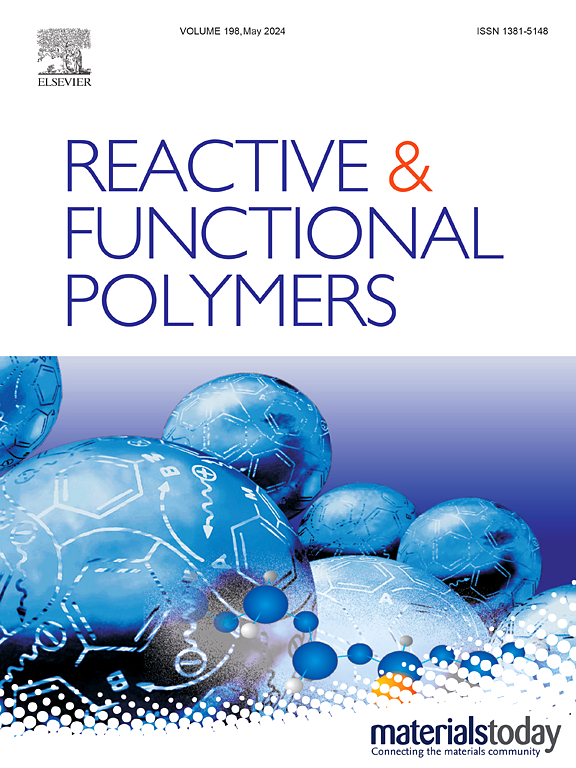Wide-temperature-range self-healing polymer based on supramolecular coordination for improving key mechanical properties of propellants
IF 4.5
3区 工程技术
Q1 CHEMISTRY, APPLIED
引用次数: 0
Abstract
Composite solid propellants still face critical issues such as matrix strength degradation, grain structure failure, and interfacial debonding, which severely compromise their reliability and operational safety. Developing polymers with superior self-healing capabilities across a wide temperature range and enhanced mechanical properties as propellant matrices, as well as synthesizing self-healing propellants, holds significant promise for addressing these challenges. In this work, by precisely controlling the quantity and spatial arrangement of ligands through analysis of the bond strength and reactivity of dynamic coordination bonds, we successfully fabricated a mechanically reinforced self-healing polymer with broad temperature adaptability. This polymer exhibits a self-healing efficiency exceeding 80 % over a wide temperature range. Concurrently, its mechanical strength is markedly improved, achieving a fracture elongation of over 1600 %. When formulated into propellant samples, the propellant demonstrates exceptional mechanical performance, without interfacial debonding problem during tensile testing. Furthermore, the incorporation of self-healing functionality shows no adverse effects on other critical properties of propellant. This work also elucidates the healing mechanisms of the polymer and propellant system, as well as the principles underlying their mechanical reinforcement. The developed polymer exhibits high feasibility for propellant applications, offering a novel strategy for advancing research on self-healing composite solid propellants.
改善推进剂关键力学性能的基于超分子配位的宽温度范围自愈聚合物
复合固体推进剂仍然面临着基体强度退化、颗粒结构破坏和界面脱粘等关键问题,严重影响了其可靠性和使用安全性。开发在宽温度范围内具有优异自愈能力和增强机械性能的聚合物作为推进剂基质,以及合成自愈推进剂,为解决这些挑战带来了重大希望。在这项工作中,通过分析动态配位键的键强度和反应性来精确控制配体的数量和空间排列,我们成功地制造了一种具有广泛温度适应性的机械增强自愈聚合物。该聚合物在较宽的温度范围内显示出超过80%的自愈效率。同时,其机械强度显著提高,断裂伸长率超过160%。当配制成推进剂样品时,推进剂表现出优异的机械性能,在拉伸试验中没有界面脱粘问题。此外,自愈功能的加入对推进剂的其他关键性能没有不利影响。这项工作还阐明了聚合物和推进剂系统的愈合机制,以及它们的机械强化原理。该聚合物具有较高的推进剂应用可行性,为推进自修复复合固体推进剂的研究提供了新的思路。
本文章由计算机程序翻译,如有差异,请以英文原文为准。
求助全文
约1分钟内获得全文
求助全文
来源期刊

Reactive & Functional Polymers
工程技术-高分子科学
CiteScore
8.90
自引率
5.90%
发文量
259
审稿时长
27 days
期刊介绍:
Reactive & Functional Polymers provides a forum to disseminate original ideas, concepts and developments in the science and technology of polymers with functional groups, which impart specific chemical reactivity or physical, chemical, structural, biological, and pharmacological functionality. The scope covers organic polymers, acting for instance as reagents, catalysts, templates, ion-exchangers, selective sorbents, chelating or antimicrobial agents, drug carriers, sensors, membranes, and hydrogels. This also includes reactive cross-linkable prepolymers and high-performance thermosetting polymers, natural or degradable polymers, conducting polymers, and porous polymers.
Original research articles must contain thorough molecular and material characterization data on synthesis of the above polymers in combination with their applications. Applications include but are not limited to catalysis, water or effluent treatment, separations and recovery, electronics and information storage, energy conversion, encapsulation, or adhesion.
 求助内容:
求助内容: 应助结果提醒方式:
应助结果提醒方式:


